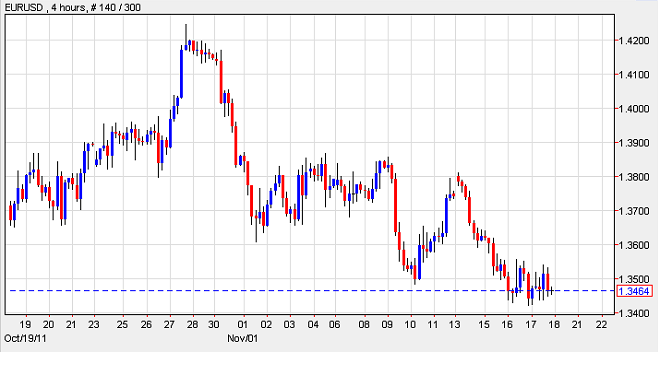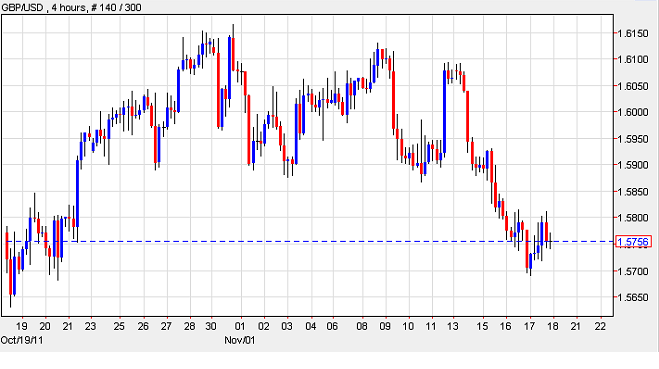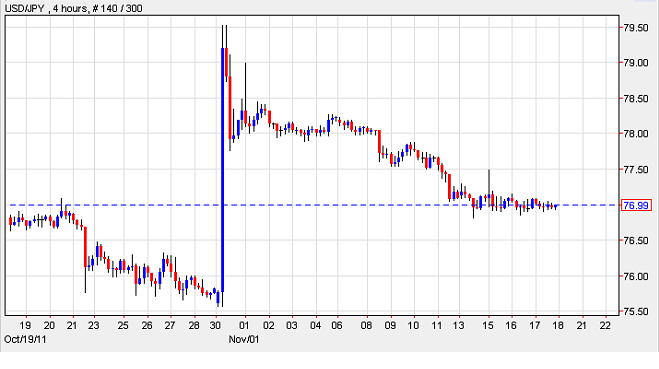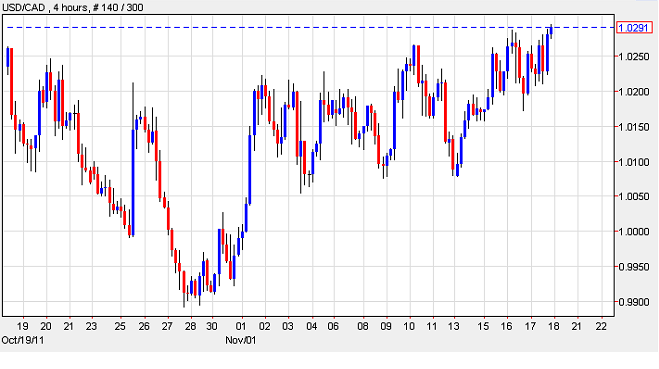The U.S. Dollar weakened slightly as investors sought risk assets following the release of positive U.S. data. Reports revealed that U.S. Unemployment Benefit Claims dropped to 388k
The U.S. Dollar weakened slightly as investors sought risk assets following the release of positive U.S. data. Reports revealed that U.S. Unemployment Benefit Claims dropped to 388k in the past week, and Continuing Claims fell to 3.61m, which was the lowest rate since 2008. Other statistics indicated that Housing Starts climbed to 0.63m in October and Building Permits went up from 0.60m to 0.65m. The better than anticipated figures supported an optimistic outlook for the country’s economy which in turn boosted demand for risk assets. Meanwhile, the Canadian Dollar dipped to its lowest level in five weeks as the Euro zone’s debt crisis overshadowed foreign investments in Canadian securities. The Loonie slipped versus the U.S. Dollar as demand for refuge increased after Spain’s 10-year yields rose to pre-Euro era highs. Canada’s currency managed to erase some of the losses in early trading on reports that the ECB purchased Italian bonds.
The Euro advanced against the majority of its peers as the decline in Italian bonds overshadowed the existing debt crisis. The shared currency traded mixed against the greenback and the Yen after sources revealed the European Central Bank had bought additional Italian government bonds. But the Euro erased those gains against Japan’s currency after stocks plummeted for a second day. The Euro remained unchanged despite the fact that Spain’s 10-year bonds rose 1.5 points. However, analysts say that the stellar data out of the U.S. is the factors which actually supported risk appetite and caused the Euro to trade higher. Other news showed that France also faced higher borrowing costs after an auction in which some of the yields climbed sharply, and the spread over the German bonds broke the 2 percent level. Meanwhile, Italy’s new Prime Minister, Mario Monti, laid out his plan to stop tax evasion and make reforms to the tax system. The British Sterling advanced following reports indicating an increase in Retail Sales in the U.K. for the month of October. The Sterling received a boost from better than expected data out of the U.S. which raised risk appetite in the market.
Japan’s Yen traded flat as risk appetite increased on the better than expected Jobless data out of the U.S. The Yen continued flat despite the fact that a hike in borrowing costs in the Euro region dampened demand for risk assets and pushed investors to seek refuge.
Lastly, both the Australian and New Zealand Dollars slumped to their lowest levels in over a month versus the greenback on worries that the global economies will slow down because E.U. leaders failed to contain the debt crisis. The Aussie Dollar slipped further against the U.S. currency after Spain sold its bonds at the highest yields in seven years, causing stocks and commodities to depreciate. The New Zealand Dollar also traded at a six-week low versus the Yen and the U.S. monetary unit after reports revealed that Producer Input Prices advanced at the slowest pace in two years.
EUR/USD- Borrowing Costs Climb Higher
The Euro benefitted from risk appetite in the market despite the hike in borrowing costs. Yields on Spanish 10-year bonds reached close to 7 percent, up from 5.43 on October 20th. Auction of French notes also showed that yields rose from 2.31 to 2.82 percent. Other news revealed that there’s also been a decline in demand for Belgian and French securities as investors continue to lose confidence in the Euro zone. However, a decline in the Italian bond yields distracted investors from their ongoing concerns over the worsening of the crisis. The shared currency fluctuated throughout the day on rumors that the European Central Bank bought additional Italian government bonds, after having purchased some in the morning. On the economic front, the calendar was light for the Euro zone. The only data indicated that Construction Output fell by -1.3 percent in September.

GBP/USD- Retail Sales Climb
The British Pound rose as data showed that Retail Sales climbed in the U.K. for October. Metrics indicated that consumers spent an additional 0.6 percent despite the slowdown in wage increases and the rate of inflation. The Pound also gained against the U.S. Dollar as better than expected stats revealed the world’s largest economy is on its way to recovery, thus boosting risk appetite. But not everything is rosy for the U.K. as this week’s metrics showed that Unemployment climbed to 8.3 percent and the Bank of England predicted a lower growth rate.

USD/JPY- BOJ Issues Warning
While the Yen traded flat on fluctuations of risk trends in the market, the Bank of Japan issued a warning, letting investors know that the country faces an economic slowdown in the fourth quarter, especially in the export sector. The Bank of Japan kept the interest rates at 0.10 percent and refrained from implementing additional asset purchasing. However, economists fear that the Euro region’s crisis will have a serious effect on Japan’s economy and it could indeed affect the entire world. On the economic front, reports showed that Machine Tool Orders remained almost unchanged in October.

USD/CAD- See-Saw Day For The Loonie
Canada’s Dollar advanced on indications the ECB had purchased Italian bonds. However, the currency declined to the lowest price in five weeks as the drop in stocks and commodities eclipsed foreign investments in the country’s securities. Data showed that foreign investors bought 7.24 billion Canadian Dollars in treasury bills in the month of September, indicating that the world still sees the Canadian currency as a safe bet. The Loonie slipped as crude oil fell 3.1 percent reaching $98.64 a barrel, and as borrowing costs rose the most in seven years at an auction of Spanish securities.

Today’s Outlook
Today’s economic calendar is light. It shows that Canada will report on CPI and Core CPI as well as its Leading Indicators. Italy will release Italy’s Industrial New Orders and German PPI.
The U.S. Dollar weakened slightly as investors sought risk assets following the release of positive U.S. data. Reports revealed that U.S. Unemployment Benefit Claims dropped to 388k in the past week, and Continuing Claims fell to 3.61m, which was the lowest rate since 2008. Other statistics indicated that Housing Starts climbed to 0.63m in October and Building Permits went up from 0.60m to 0.65m. The better than anticipated figures supported an optimistic outlook for the country’s economy which in turn boosted demand for risk assets. Meanwhile, the Canadian Dollar dipped to its lowest level in five weeks as the Euro zone’s debt crisis overshadowed foreign investments in Canadian securities. The Loonie slipped versus the U.S. Dollar as demand for refuge increased after Spain’s 10-year yields rose to pre-Euro era highs. Canada’s currency managed to erase some of the losses in early trading on reports that the ECB purchased Italian bonds.
The Euro advanced against the majority of its peers as the decline in Italian bonds overshadowed the existing debt crisis. The shared currency traded mixed against the greenback and the Yen after sources revealed the European Central Bank had bought additional Italian government bonds. But the Euro erased those gains against Japan’s currency after stocks plummeted for a second day. The Euro remained unchanged despite the fact that Spain’s 10-year bonds rose 1.5 points. However, analysts say that the stellar data out of the U.S. is the factors which actually supported risk appetite and caused the Euro to trade higher. Other news showed that France also faced higher borrowing costs after an auction in which some of the yields climbed sharply, and the spread over the German bonds broke the 2 percent level. Meanwhile, Italy’s new Prime Minister, Mario Monti, laid out his plan to stop tax evasion and make reforms to the tax system. The British Sterling advanced following reports indicating an increase in Retail Sales in the U.K. for the month of October. The Sterling received a boost from better than expected data out of the U.S. which raised risk appetite in the market.
Japan’s Yen traded flat as risk appetite increased on the better than expected Jobless data out of the U.S. The Yen continued flat despite the fact that a hike in borrowing costs in the Euro region dampened demand for risk assets and pushed investors to seek refuge.
Lastly, both the Australian and New Zealand Dollars slumped to their lowest levels in over a month versus the greenback on worries that the global economies will slow down because E.U. leaders failed to contain the debt crisis. The Aussie Dollar slipped further against the U.S. currency after Spain sold its bonds at the highest yields in seven years, causing stocks and commodities to depreciate. The New Zealand Dollar also traded at a six-week low versus the Yen and the U.S. monetary unit after reports revealed that Producer Input Prices advanced at the slowest pace in two years.
EUR/USD- Borrowing Costs Climb Higher
The Euro benefitted from risk appetite in the market despite the hike in borrowing costs. Yields on Spanish 10-year bonds reached close to 7 percent, up from 5.43 on October 20th. Auction of French notes also showed that yields rose from 2.31 to 2.82 percent. Other news revealed that there’s also been a decline in demand for Belgian and French securities as investors continue to lose confidence in the Euro zone. However, a decline in the Italian bond yields distracted investors from their ongoing concerns over the worsening of the crisis. The shared currency fluctuated throughout the day on rumors that the European Central Bank bought additional Italian government bonds, after having purchased some in the morning. On the economic front, the calendar was light for the Euro zone. The only data indicated that Construction Output fell by -1.3 percent in September.

GBP/USD- Retail Sales Climb
The British Pound rose as data showed that Retail Sales climbed in the U.K. for October. Metrics indicated that consumers spent an additional 0.6 percent despite the slowdown in wage increases and the rate of inflation. The Pound also gained against the U.S. Dollar as better than expected stats revealed the world’s largest economy is on its way to recovery, thus boosting risk appetite. But not everything is rosy for the U.K. as this week’s metrics showed that Unemployment climbed to 8.3 percent and the Bank of England predicted a lower growth rate.

USD/JPY- BOJ Issues Warning
While the Yen traded flat on fluctuations of risk trends in the market, the Bank of Japan issued a warning, letting investors know that the country faces an economic slowdown in the fourth quarter, especially in the export sector. The Bank of Japan kept the interest rates at 0.10 percent and refrained from implementing additional asset purchasing. However, economists fear that the Euro region’s crisis will have a serious effect on Japan’s economy and it could indeed affect the entire world. On the economic front, reports showed that Machine Tool Orders remained almost unchanged in October.

USD/CAD- See-Saw Day For The Loonie
Canada’s Dollar advanced on indications the ECB had purchased Italian bonds. However, the currency declined to the lowest price in five weeks as the drop in stocks and commodities eclipsed foreign investments in the country’s securities. Data showed that foreign investors bought 7.24 billion Canadian Dollars in treasury bills in the month of September, indicating that the world still sees the Canadian currency as a safe bet. The Loonie slipped as crude oil fell 3.1 percent reaching $98.64 a barrel, and as borrowing costs rose the most in seven years at an auction of Spanish securities.

Today’s Outlook
Today’s economic calendar is light. It shows that Canada will report on CPI and Core CPI as well as its Leading Indicators. Italy will release Italy’s Industrial New Orders and German PPI.
